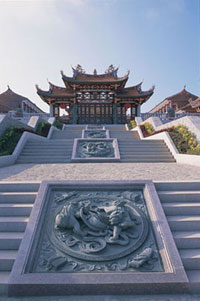Tuesday, October 27, 2009

Close to the world's tallest statue of the goddess A-Ma (also known as Tian Hou), which stands on a 170-metre high peak on a mountaintop on Macau's Coloane Island, a 7,000-square meter cultural complex celebrates the beloved deity's legend.
The development of the A-Ma Cultural Village was started during the Chung Yeung festival in 2001 shortly after the A-Ma Cultural and Tourism Festival of Macau. Today, construction of the Qing Dynasty-style complex is nearly finished. Surely the village, which comprises a bell tower, drum tower, carved marble altar in the Tian-Hou Palace, a dressing hall, museum and shops will attract many A-Ma devotees and interested tourists, especially those from the Mainland, Taiwan, Hong Kong and Fujian Province, where the goddess A-Ma is believed to have been born more than 1,000 years ago. Visitors approach the village by six rows of stairs carved with auspicious Chinese patterns like of the roaring tiger, the double lion, the five cranes and double phoenix that lead to the Tian Hou Palace. Plans for the future include a vegetarian restaurant and more Macanese and Taiwanese snack stalls, folk handicrafts and souvenir shops and other tourist facilities.

Close to the world's tallest statue of the goddess A-Ma (also known as Tian Hou), which stands on a 170-metre high peak on a mountaintop on Macau's Coloane Island, a 7,000-square meter cultural complex celebrates the beloved deity's legend.
The development of the A-Ma Cultural Village was started during the Chung Yeung festival in 2001 shortly after the A-Ma Cultural and Tourism Festival of Macau. Today, construction of the Qing Dynasty-style complex is nearly finished. Surely the village, which comprises a bell tower, drum tower, carved marble altar in the Tian-Hou Palace, a dressing hall, museum and shops will attract many A-Ma devotees and interested tourists, especially those from the Mainland, Taiwan, Hong Kong and Fujian Province, where the goddess A-Ma is believed to have been born more than 1,000 years ago. Visitors approach the village by six rows of stairs carved with auspicious Chinese patterns like of the roaring tiger, the double lion, the five cranes and double phoenix that lead to the Tian Hou Palace. Plans for the future include a vegetarian restaurant and more Macanese and Taiwanese snack stalls, folk handicrafts and souvenir shops and other tourist facilities.
Labels: Countries Tourism, Tourism attractions, World Tourism, World travel guide







0 Comments:
Post a Comment
<< Home